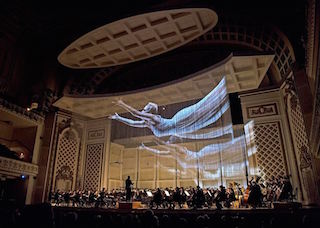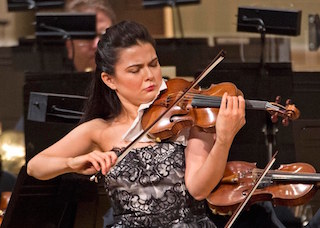
|

Karen Gomyo
|
Another instrument appeared in the "Pelleas," too, projection, used to cast images onto plastic curtains hanging above the Music Hall stage. The event was part one of a three-year “Pelleas Trilogy,” based on the 1893 Symbolist play "Pelléas et Mélisande" by Maurice Maeterlinck. Gabriel Fauré’s incidental music for the play and the opera by Claude Debussy, both with visuals, are set for 1916 and 1917, respectively.
Designed by James Darrah with photographer Adam Larsen, the visual element in "Pelleas" featured WIFE, three Los Angeles-based artists who combine surrealist animations via projection mapping, using movement and dance as a vehicle for storytelling. It was more in the spirit of the tone poem, however, than anything literal, and one missed a narrative line. Three women, Jasmine Albuquerque, Kristen Leahy and Nina McNeely, appeared on the screens in long flowing dresses, expressing various stages of the suffering of Melisande, Maeterlinck’s ill-fated heroine who falls in love with the wrong man.
The music, an early work by Schoenberg (1902-03), before he adopted
12-tone technique, is splashy and romantic in the style of Richard
Strauss. Still, the 44-minute
work, which comprised the second half of the concert, is more dismal than moving (there's a lot of suffering going on), with a recurring fate motive sounded at the outset by the bass
clarinet. The theme of this first
installment of the trilogy was entitled “Smoke” (fate), with smoke recurring in
the projections.
Langrée introduced the work at the head of the concert before the featured concerto, which seemed a bit misplaced, however welcome, with a demonstration of the fate motive by principal cellist Ilya Finkelshteyn. The tone poem unfolded in four large sections combining the various motives associated with the characters. The performance itself was powerful, with fine playing by the CSO, and received a warm response from the audience.
The concert opened with a brilliant performance of the Sibelius Violin Concerto by guest artist Karen Gomyo, making her CSO debut. Noticeable at the outset was her sweet tone (she plays a 1703 Stradivarius violin), which was caressing, but with real body and projected cleanly even in her softest moments. Her technique was unassailable, always allied to the needs of the music.
Gomyo’s performance of the opening Allegro moderato was stunning and displayed a brilliant technique, always, however, allied with the needs of the music. Her tone high on the G string was svelte in the second movement, Adagio di molto, which the CSO played with real drama.
Her mastery was also evident in the Allegro finale, where she displayed real athleticism to its blazing end. In all, it was the finest performance of the Sibelius Concerto in this listener’s memory. Gomyo’s return to the CSO cannot be too soon.